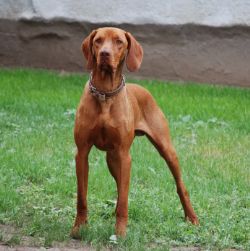Description
The Vizsla is very muscular, sleek and very athletic looking medium sized dog that is used for hunting as well as a companion pet. They are very balanced in appearance and have a typical hunting dog alertness, energy and eagerness about them at all times. The Vizsla is always a beautifully coppery gold to rust color and has a shorter coat, although it is very dense and thick.
The Vizsla has a typical hunting dog\'s head with a wide, slightly dome forehead with a noticeable line or cleft up the center. The muzzle is long and tapering gently to a well formed brownish colored nose and mouth. The lips are tight to the well developed teeth, not noticeably loose or pendulous. The eyes are alert and intelligent looking and are blend with the color of the coat. An amber or yellowish eye color is typical in most Vizslas. The ears fold over close to the head and hang down the sides of the face. They are typically rather long and reach to approximately the line of the lower jaw.
The neck is strong and well formed, flowing into a strong back and well formed body area. These dogs have a moderately wide and deep chest and straight and powerful legs. The tail is typically docked to about two thirds of its natural length but may also be left natural. The feet are rounded and well formed.
The Viszla has a very energetic movement and has a naturally springy step. They are a very alert yet friendly dog, ready to wag their tail at everyone and join in a game with the family.
History
The history of the Vizsla begins with the Magyar horde, a warlike, nomadic tribe, wandering all across Central Europe until settling in Hungary. A depiction of the breed first appears in the 10th century followed by closer renditions and a written reference in the Illustrated Vienna Chronicle, a 14th century manuscript. The breed\'s survival was secured by the involvement of several barons. They liked the breed and admired its ability to hunt. Early breeders included the Batthyany, Nadasdy and Zay families. They and the land honed the Vizsla\'s hunting skills into a fine art, testing and perfecting the ability to scent, point and retrieve.
After World War I, concerned parties made a concerted effort to ensure the breed remained unique and survived the century. The Hungarian Kennel Club (MEOE) established strict breed standards. All seemed assured. World War II, however, eradicated much of the breed, destroying the studbook registry. A breeding colony had to be established.
The AKC admitted the breed into its registry in 1960. By 1971, the breed began, again, to receive serious international recognition. Since then, the Vizsla has become a recognized competitor at hunting trials and specialty shows as well as at various other dog shows worldwide.
Temperament
The Vizsla is affectionate, gentle and vulnerable. The dog is also protective of its owner and adopted family. The breed is fearless and intelligent. A loyal animal, Vizslas attach and bond quickly to their owner, forming close, tight-knit ties. A Vizsla will follow you from room to room, as you wander throughout your house. Their sometimes, clinging ways leads to their nickname of "Velcro" dog.
The Vizsla is not a noisy dog. It is quiet, barking only if goaded or the circumstances warrant it. This does not make them passive. Vizslas can be both aggressive and destructive. Highly intelligent dogs with a need to be active, they become bored and restless if not stimulated or exercised. If left cooped up too long, a Vizsla is a destructive animal; if bored, a Vizsla will resort to eating anything and everything, stealing food from off tables or countertops. Vizslas, well bred though they may be, are not adverse to overturning and gobbling the contents of garbage cans. You can sometimes find a mildly bored Vizsla lying on tables or other places it should not climb. Overall, the Vizsla is a gentle, quiet, good-natured dog and highly intelligent. It is confident and likes to be with people, even children. This breed however, needs sufficient training to keep both you and it happy and content.
Thyroid Disease - Medium Risk
The Vizsla ranks #50 among all breeds for autoimmune thyroiditis prevalence. While this is not a high risk breed, there is still a good chance of disease transmission through breeding. Therefore, all dogs intended for breeding should be tested first.
| Rank Among Breeds |
Number of Dogs Tested |
Percent of Dogs With Disease |
| #50 |
672 |
7.9% |
You can download the full report (on all breeds) by the Michigan State University Diagnostic Center for Population and Animal Health. Here
Other Health Problems
The interbreeding to preserve the line results in a number of inherited health issues. While these conditions do not occur in all lines they can include:
- Eye diseases and problems among Vizslas include progressive retinal atrophy, entropion, ectropion and corneal dystrophy. Ectropion, or loose eyelids, gives your dog a sagging-eyed look. With entropion, the hairy skin surrounding the eye acts as an irritant.
- Stomach or digestive system difficulties include dysphagia- megaesophagus. A Vizlas with this condition struggles to swallow. There is also associated muscle wasting and excessive drooling.
- Allergies to food and some plant life. Owners have noted the development of rashes on their dogs after romps through the woods.
- Sebaceous adenitis or inflamed skin glands.

